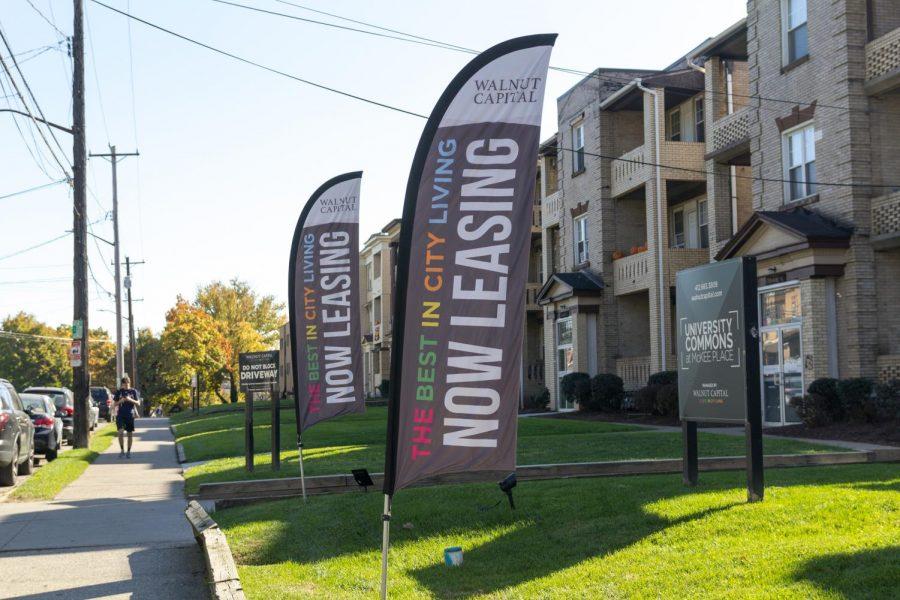‘Very impressed’: Walnut Capital, residents reflect on Oakland Crossings revisions
John Blair | Senior Staff Photographer
Walnut Capital advertisements in South Oakland.
April 20, 2022
With zoning changes for developer Walnut Capital’s Oakland Crossings project heading back to Pittsburgh City Council, president Todd Reidbord said the company and City officials compromised on the changes.
“I was very, very impressed with the Gainey administration,” Reidbord said. “The people that we worked with didn’t want to take no for an answer, and they said, ‘Let’s find a way to make this work.’ So in the end, I think we really came out where we needed to be.”
The final proposal was a joint effort between Walnut Capital and Pittsburgh Mayor Ed Gainey’s administration. The revisions narrowed down the proposal to be more limited in scope and accommodate the concerns voiced by Oakland residents. The City Planning Commission unanimously approved the proposal on March 22, moving it to Pittsburgh City Council for a final vote.
The rezoning proposal is the first step in Walnut Capital’s Oakland Crossings project. The project seeks to replace homes on Halket Street, the former Quality Inn site and Isaly’s site with apartments, retail businesses including a grocery store and more open space.
The proposal has been in the works since last fall, and was initially approved by City Council under former Mayor Bill Peduto’s administration. The plan was set to be voted on by the City Planning Commission in January, but the newly elected Mayor Gainey delayed it after entering office.
Corey Layman, Pittsburgh’s zoning administrator, said the Gainey administration collaborated with Walnut Capital to reach a compromise.
“In this case, there was a lot of coordination with the applicant (who is the Mayor’s office), the interested developer of the property being rezoned, and the Department of City Planning,” Layman said, “which led to an agreement to substantially amend the original bill before the Planning Commission, and it was on that amended bill that they voted to recommend for approval to City Council.”
The revisions addressed many community concerns about earlier iterations of the plan. McKee Place, Zulema Park and Louisa Street were all removed from the area designated for rezoning. Reidbord said removing these properties was a compromise Walnut Capital was willing to make to get the project moving.
“The mayor came to us and said, ‘Let’s just do what we need to do now to get this important project off the ground,’” Reidbord said. “It’s not something that we would have chosen to do, but in the spirit of compromise, we felt it was a reasonable request and a reasonable solution.”
Reidbord added that these properties may be included in a future rezoning initiative.
“We’re optimistic that, as the Oakland Plan moves forward, we’ll end up at the same place that we would have if we had the rezoning now,” Reidbord said. “We’re going to use those [properties], particularly McKee, in later phases anyway.”
The revisions also narrow down the allowed uses for the zoning area. University campus, restaurants, fast food and utility were all removed from the permitted uses. Halket Street is currently classified as residential, while the Quality Inn and Isaly’s sites are currently designated as part of the Oakland Public Realm. The rezoning will redesignate all of these areas as an “Urban Center-Mixed Use,” which allows for taller, higher density buildings as well as mixed-use development.
While the commission’s March 22 vote was 5-0 in favor of approving the zoning changes, some commission members and Oakland residents still have concerns. The main concern remaining was the height limit for buildings on Halket Street. Andrea Boykowycz, assistant director of the Oakland Planning and Development Corp., said the heights in the proposal could impact neighboring property owners.
“There are others who feel like this would really negatively impact their quality of life,” Boykowycz said. “They bought their houses and they’ve lived in this neighborhood for decades with an understanding that the buildings immediately proximate to them are other houses that are like theirs and not tall skyscrapers with lots of people coming and going.”
The proposal allows for buildings up to 65 feet on Halket Street, and up to 185 feet in sections bordering the Boulevard of the Allies. Reidbord said Walnut Capital will most likely build close to the maximum height allowed, while adding that he thinks concerns about height are somewhat misconstrued.
“Height to me is a false narrative in terms of, you know, why are you against height? I mean, are you against the height of the Cathedral of Learning?” Reidbord said. “If you think about where tall buildings should be in Pittsburgh, I think Oakland is certainly one of the places where they should be.”
Boykowycz also said OPDC is concerned with the example that is being set with the process followed for the Oakland Crossings initiative, even if many of the changes are positive.
“It doesn’t set a very healthy precedent for neighborhood planning anywhere in the City that there can be this kind of effort where you go around planning in this way,” Boykowycz said. “But I think that the resolution that is being proposed here at least brings everybody into the process.”








